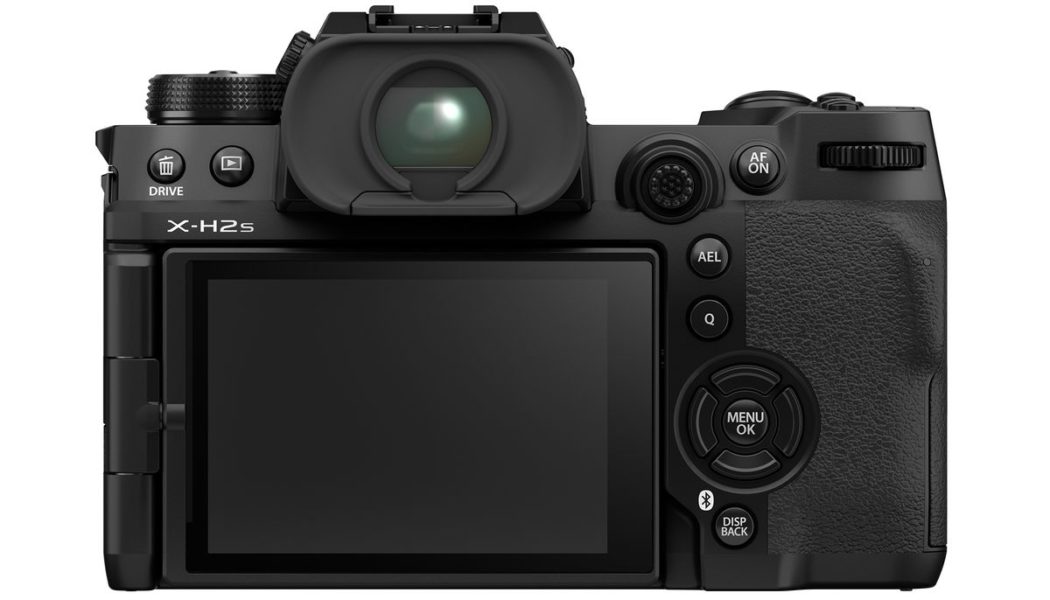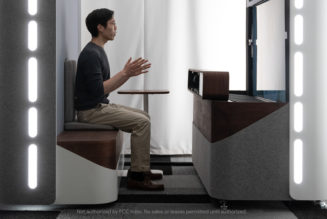Fujifilm’s latest X-Summit event is happening today in Omiya, Japan, and it brings several new announcements for its X-series of APS-C mirrorless cameras, including two cameras and two lenses. The headliner is the 26-megapixel X-H2S camera, which Fujifilm calls its new high-speed flagship model. It is the successor to 2018’s X-H1 and will launch on July 7th for $2,499 (without a lens).
Joining this camera at release is a new XF 150-600mm super-telephoto zoom lens costing $1,999, with an XF 18-120mm powered zoom due out later in mid-September for $899. Fujifilm also teased another camera, the X-H2, with a new 40-megapixel non-stacked sensor that’s also coming in September.
These new cameras are more pro DSLR-like than anything else in Fujifilm’s X-series of cameras, eschewing classic shutter speed and ISO dials in favor of a more modern PSAM dial. While the X-H2S maintains a modest resolution that’s only two megapixels more than its predecessor, its biggest improvements are in its speed, autofocus tracking capabilities, and hybrid video shooting. The new 26-megapixel backside-illuminated APS-C sensor has a stacked design, allowing faster readout speeds that permit blackout-free shooting up to 40fps with its electronic shutter — while maintaining continuous autofocus tracking. Unlike the Nikon Z9, the X-H2S has a mechanical shutter, though it tops out at a much lower 15fps burst rate.
:no_upscale()/cdn.vox-cdn.com/uploads/chorus_asset/file/23594094/fujifilm_x_h2s_rear.jpg)
:no_upscale()/cdn.vox-cdn.com/uploads/chorus_asset/file/23594095/fujifilm_x_h2s_top.jpg)
The other key component to the X-H2S’s newfound speed is its fifth-generation X Processor that clocks in at 1GHz, with a 600MHz sub-processor dedicated entirely to handling the new five-axis in-body image stabilization system — which Fujifilm claims is capable of up to seven stops of stabilization. For comparison, the older fourth-gen processor ran a peak of 608MHz for all tasks.
That newfound headroom may prove vital, as processor-heavy autofocus systems with real-time subject tracking have made big leaps in recent years, and Fujifilm is trying to play catchup with the likes of Sony and the latest offerings from Canon and Nikon. The X-H2S can perform three times more autofocus calculations than Fujifilm’s own X-T4, and Fujifilm says its new Deep Learning AI allows for subject detection and the tracking of human faces and eyes, animals, birds, automobiles, bikes, airplanes, and trains. In Zone AF mode, the camera favors closer subjects that are centered in the frame — ideally picking out the main person from a group.
Since the X-H2S is designed for hybrid photo and video use, it has a fully articulating three-inch 1.62 million-dot LCD and 5.76 million-dot EVF with 0.8x magnification, where the X-H1 had a more limited dual-hinge LCD design that could not face forward and a 3.69 million-dot EVF with 0.75x magnification. Also, the X-H2S gains a much-needed headphone jack to go with its 3.5mm mic port as well as an upgrade from Micro USB to USB-C — with the ability to natively use it as a webcam without any additional software. As for its video recording specs, they are bumped up to 6K at 30fps, 4K up to 120fps, and 1080p up to 240fps. It can record these resolutions and frame rates in Apple ProRes format internally to its new CFexpress Type B primary card slot (the secondary card slot is the more typical SDXC UHS-II). For hardcore videographers looking to film in RAW, they’ll have to record externally via the camera’s HDMI 2.1 connection — outputting to ProRes RAW or Blackmagic RAW.
Fujifilm says that the new F-Log2 video profile allows for up to 14 stops of dynamic range, and when it comes to recording time, the X-H2S is rated to run for up to 240 minutes in 4K60P at a temperature of 25 degrees Celsius / 77 degrees Fahrenheit or 20 minutes at 40 degrees Celsius / 104 degrees Fahrenheit. By purchasing an add-on cooling fan for $199, that high-temperature time more than doubles to 50 minutes of recording. We haven’t seen a first-party add-on cooling solution from a camera maker before, but cameras with built-in fans are a staple of the video world. Having an optional fan may be a logical compromise to releasing a separate model dedicated to video, like Panasonic’s S1H.
:no_upscale()/cdn.vox-cdn.com/uploads/chorus_asset/file/23594088/16757344_PT02_Image_X_H2S_back_fan.jpg)
Over on the lens front, Fujifilm has two new zooms: big and small. The XF 150-600mm f/5.6-8 R LM OIS WR doesn’t have the brightest aperture, but it’s a super-telephoto with a full-frame equivalent reach of 229 to 914mm with all zooming being done inside the barrel. The other new lens is the XF 18-120mm f/4 LM PZ WR with a powered zoom for smoother control of zoom and focus pulls. As for further lens development, Fujifilm is adding adding the XF 56mm f/1.2 II, XF 30mm f/2.8 Macro, and XF 8mm f/3.5 to its lens roadmap, with details to come later this year.
:no_upscale()/cdn.vox-cdn.com/uploads/chorus_asset/file/23594085/16754500_PT25_Image_X_H2S_sideUSB_XF150_600mm_XF2Xtelecon.jpg)
The company is also teasing another camera for a September release. The X-H2 — no “S” — is a 40-megapixel version of the X-H2S. Not much info about this model is available at this time aside from the resolution, but it’s safe to assume it shares many features with its lookalike sibling with an added focus on high-resolution imagery. This will be the first time a camera in the X-line is split into high-speed and high-resolution versions, though it’s a formula other manufacturers have used for decades — particularly in models catering to professionals.
While Fujifilm, like many other companies, has been hit fairly hard with shipping constraints across many of its cameras, the X-H2S is being given a bit of lead time before it’s scheduled to begin shipping in July. It’s the priciest Fuji X camera to date, and launching alongside it will be a $399 vertical grip and the $199 cooling fan. A second vertical grip option, designed for speedier wireless and wired ethernet connectivity, will cost a whopping $999 and launch in early September.
Fujifilm’s second generation of H cameras seem like sizable upgrades to a line that looked nearly forgotten. As its GFX medium format cameras reach lower price floors, the smaller and lighter APS-C X-line is creeping upward with a higher ceiling — narrowing a feature gap to try and prevent losing customers to new competition in full-frame systems from other brands. The X-H2S and X-H2 look a bit like the company is conforming to more recent trends to directly compete with higher-end models from Canon, Sony, and Nikon and diverging even more from Fujifilm’s typically retro-inspired designs. The X-H2S and X-H2 need to deliver on their performance in autofocus, video, and speed to help overcome the “but it’s not full-frame” complaint often levied at the X-line, while also giving existing Fujifilm users more reasons to upgrade within the line.
Update May 31st, 10:09AM ET: Added details about Fujifilm’s lens roadmap with three more upcoming lenses.








